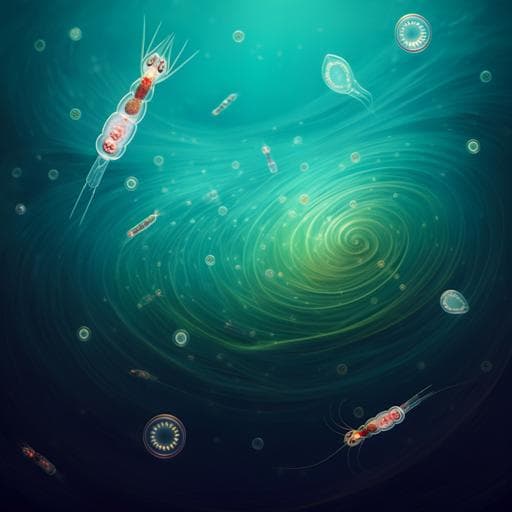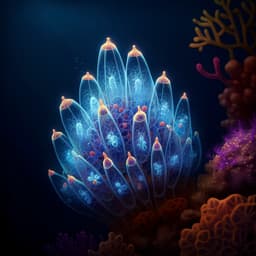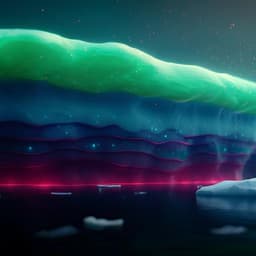
Earth Sciences
Decline in plankton diversity and carbon flux with reduced sea ice extent along the Western Antarctic Peninsula
Y. Lin, C. Moreno, et al.
This exciting study by Yajuan Lin and colleagues unveils how declining sea ice extent dramatically influences plankton biodiversity and carbon cycling in the Western Antarctic Peninsula. Discover how rising sea surface temperatures are linked to biodiversity loss and how machine learning predicts plankton community shifts with 80% accuracy, shedding light on our changing oceans!
~3 min • Beginner • English
Introduction
The Southern Ocean plays a disproportionate role in global climate by taking up nearly half of anthropogenic CO2 and most of the oceanic heat. The Western Antarctic Peninsula (WAP) has undergone rapid environmental change, including atmospheric and ocean warming, freshening, deepening mixed layers, and significant reductions in sea ice extent. These shifts have cascaded through the marine food web. At the base of this web, eukaryotic plankton (phytoplankton and micro-zooplankton) underpin higher trophic levels, drive biogeochemical cycles, and regulate oceanic carbon uptake. Net community production (NCP) reflects the balance of gross primary production and community respiration and indicates organic carbon available for export from the mixed layer. The study aims to determine how sea-ice conditions and associated physical changes influence plankton community structure, biodiversity, and NCP along the WAP, and to develop predictive models linking community composition and environmental drivers to biological carbon fluxes.
Literature Review
Prior work has documented rapid regional warming along the Antarctic Peninsula, changes in mixed layer depth and sea ice extent, and ecosystem responses across trophic levels. Elevated NCP and primary production under high sea-ice conditions have been attributed to enhanced stratification and light availability, and possibly iron inputs from sea ice. Decadal analyses linked bloom-favorable conditions to negative phases of the Southern Annular Mode, which increase winter ice extent and spring/summer stratification. Global analyses (e.g., Tara Oceans) identified temperature as a major driver of plankton diversity (generally lower diversity at high latitudes), though Southern Ocean sampling was limited. Previous WAP studies have related NCP to photosynthetic efficiency (Fv/Fm) and suggested significant roles for micro-zooplankton grazing and the microbial loop in carbon cycling. This study builds on these insights by combining high-resolution O2/Ar-based NCP estimates with multi-year 18S rRNA metabarcoding, network analyses, and machine learning to assess biodiversity–function relationships in a data-sparse polar region.
Methodology
Study region and sampling: Annual January Palmer LTER cruises (2012–2016) surveyed shelf transects and a north–south gradient along the WAP. Underway measurements and surface water sampling were conducted via the ship’s continuous flow-through system; discrete depth profiles were collected using a CTD rosette. Mixed layer depth (MLD) was estimated using a density threshold Δσθ = 0.03 kg m−3.
Environmental and remote sensing data: PAR above-water was recorded and converted to just-below-surface PAR (factor 0.92) and to mixed-layer average PAR (PAR_mld). Freshwater fractions (sea-ice melt and meteoric water) were estimated by a three-endmember mass balance using salinity and δ18O. January sea-ice concentrations (25 km grid) were from NSIDC (1979–2020); January SST was from AVHRR (1982–2012) and MODIS-Aqua (2013–2020). Gridded environmental data were extracted over the Palmer grid.
O2/Ar-based NCP: Seawater O2/Ar ratios were measured continuously by equilibrator inlet mass spectrometry (EIMS). Biological O2 supersaturation was computed as [(O2/Ar)sample − (O2/Ar)sat]/(O2/Ar)sat × 100%. Mixed-layer NCP (mmol O2 m−2 d−1) was derived from Δ(O2/Ar), gas transfer velocity k (wind-based), and [O2]sat: NCP = k × [O2]sat × Δ(O2/Ar). Gas exchange weighting followed updated formulations. These NCP estimates reflect mixed-layer carbon fluxes and correlate with seasonal DIC drawdown (R2 ≈ 0.83 in the region).
DNA extraction and 18S metabarcoding: Surface seawater was filtered onto 47 mm Supor filters (0.45 μm in 2012–2013; 0.2 μm in 2014–2016). Filters were stored at −80°C. Cells were lysed by bead-beating; DNA was extracted with Qiagen DNeasy Plant Mini Kit. Dual-indexed 18S rRNA V4 amplicons were generated with primers EukF/EukR, PCR’d (30 cycles, 57°C annealing) in triplicate with blanks, purified, pooled (~10 ng/μl), and sequenced on Illumina MiSeq 300PE (three runs).
Sequence processing and taxonomic assignment: Paired reads were assembled with VSEARCH, demultiplexed in QIIME, adapter/primer-trimmed with BBDuk, and processed with DADA2 (v1.10.1) for quality filtering, denoising, chimera removal, and ASV inference. A total of 2,480 ASVs (119 samples) were identified (median 67,547 reads/sample post-filter). Taxonomy was assigned using DADA2’s naive Bayesian classifier against SILVA 132 (DADA2-formatted).
Alpha diversity and CCA: After discarding two lowest-count libraries, 117 samples were rarefied to even depth. Chao1, Shannon, and Pielou’s evenness were computed (phyloseq). Canonical correspondence analysis (vegan) related ASV composition to environmental variables. Fourteen variables were considered initially; a stepwise AIC-based selection (1,000 permutations/step) identified the final set.
Quantitative microbiome profiling (QMP): An internal standard (Schizosaccharomyces pombe gDNA) was spiked: 0.88 ng in 2014 and four 2013 samples (insufficient reads ≤0.1%); 16.0 ng in 2012, remaining 2013, and 2015 (yielding 0.7–5.7% of 18S reads). 2016 lacked internal standards. For samples with adequate internal standard, ASV counts were normalized to 18S gene copies L−1 using internal standard reads and filtration volumes. For batches without reliable internal standard, QMP used an empirical relationship between alloxanthin (μg/L) and cryptophyte 18S copies (y = 2.05 × 10^x; R2 = 0.94) within calibration range 0.01–6.22 μg/L, with recalculation for two outliers via Phaeocystis CHEMTAX. A complementary HPLC-CHEMTAX normalization (2013–2016) yielded QMP_recal highly consistent with internal-standard QMP (y = 0.99x, R2 = 0.87), except one sample.
Network analysis (WGCNA): Low-prevalence ASVs (not observed >3 times in ≥20% samples) were removed. Using WGCNA (v1.66) on log-transformed QMP (n = 112 samples), a soft-threshold power of 4 achieved scale-free topology (R2 = 0.9). Dynamic tree cut with minimum module size 10 identified 12 modules (bio-assemblages). Module eigengenes (eigenvalues) summarized assemblage abundances. Module–environment correlations were computed; co-occurrence networks were visualized in Cytoscape.
Genetic programming (GP) for NCP prediction: GP (Eureqa v1.24.0) constructed statistical models of volumetric NCP using inputs: 12 WGCNA module eigengenes and physical variables (MLD, PAR, PAR_mld, Salinity, SST, fraction of sea-ice melt (fsim), fraction of meteoric water (fmet), X grid (distance offshore), Y grid (north–south)). The dataset (n = 112) was randomly split into training and validation subsets. Candidate solutions were ranked by mean squared error with complexity minimized to reduce overfitting. Model performance was evaluated by R2 and MSE on validation data.
Key Findings
- NCP spatial–temporal patterns: Summer (January) NCP (2012–2016) showed strong spatial heterogeneity, highest on the shelf and decreasing offshore. Interannual variability was linked to ice conditions: years with late sea-ice retreat (2014, 2016) had abnormally high summer NCP (t-test, p < 0.0001).
- Community composition and sea ice: At the phylum level, surface eukaryotic plankton were dominated by diatoms (25.0%), cryptophytes (23.0%), dinoflagellates (19.6%), and haptophytes (11.3%). High sea-ice years (2014, 2016) averaged 39.5 ± 3.0% diatoms, 20.5 ± 1.3% dinoflagellates, 15.1 ± 6.1% cryptophytes, 7.1 ± 2.4% haptophytes. Warm, low-ice years (2012, 2013, 2015) averaged 28.9 ± 8.3% cryptophytes, 19.0 ± 1.6% dinoflagellates, 14.4 ± 4.4% haptophytes, 14.0 ± 1.7% diatoms (all differences vs cold years significant at p < 0.0001).
- Environmental drivers of community structure: CCA indicated dominant control by ice conditions/SST. CCA1 (17.5% variance) separated late vs early ice-retreat years; SST was strongly negatively associated, while Chl and biological O2 were positively associated. CCA2 (7.3%) differentiated offshore vs nearshore (driven by distance to coast and MLD). CCA3 (5.7%) reflected north–south gradients and potential interannual ice variability.
- Biodiversity declines with warming: Alpha diversity metrics decreased with higher SST. Chao1 (richness) declined by ~40% over a 4°C SST increase (R = −0.44, p = 6.1×10−7). Pielou’s evenness (R = −0.29, p = 0.0018) and Shannon (R = −0.33, p = 2.3×10−4) were also negatively correlated with SST, indicating communities in warmer waters were less rich and more uneven.
- Machine-learning prediction of NCP: GP models using WGCNA modules and physical variables achieved R2 = 0.70–0.80. Among physical predictors, SST and MLD were most frequently selected, followed by surface PAR, suggesting temperature and light limitation/proxy for time since ice retreat.
- Key bio-assemblage predictor: The turquoise module (MET; 126 ASVs, mainly diatoms and dinoflagellates) was the strongest biological predictor of NCP, appearing in all top-four GP solutions and alone explaining R2 ≈ 0.70 in one model. Central taxa included Thalassiosira, Odontella, Porosira, Actinocyclus, Proboscia, Chaetoceros (diatoms), and Gyrodinium (dinoflagellate).
- MET correlations: MET was associated with low SST (R = −0.51, p = 1×10−8), low salinity (R = −0.48, p = 8×10−8), shallow MLD (R = −0.36, p = 1×10−4), higher sea-ice melt (R = 0.33, p = 3×10−4) and meteoric water (R = 0.34, p = 3×10−4). MET correlated positively with NCP (R = 0.57, p = 8×10−11), primary production (R = 0.47, p = 1×10−7), and bacterial production (R = 0.61, p = 2×10−12), indicating high biological activity in MET-dominated regions.
- Additional modules: MER (red; 27 ASVs; dominated by cryptophyte Geminigera) positively contributed to NCP in some models; it correlated with warmer SST (R = 0.45, p = 6×10−7) and northern WAP (R = 0.40, p = 2×10−5). MEG (green; 29 ASVs; heterotrophic protists Picomonas, Telonema) negatively contributed to NCP; it correlated with deeper MLD (R = 0.50, p = 2×10−8) and greater distance offshore (R = 0.49, p = 6×10−8).
- Conceptual regimes for summer WAP: (i) Ice-melt conditions favor large centric diatom blooms, short food chains (krill to apex predators), and high export. (ii) Warmer, low-ice waters favor small cryptophytes, with stronger micro-zooplankton grazing, longer food chains, and lower export. (iii) Deep mixing leads to light limitation, dominance of heterotrophic protists and microbial-loop recycling, lowest NCP and reduced export.
Discussion
Findings demonstrate a tight coupling between sea-ice conditions, physical stratification, and eukaryotic plankton community structure at the WAP. Lower SST and shallow MLD associated with extensive sea ice favor diverse diatom–dinoflagellate assemblages that enhance NCP and export potential. Warmer conditions and/or deeper mixing shift communities toward less diverse, cryptophyte-dominated or heterotrophic protist-dominated assemblages, reducing NCP and export through increased grazing, longer trophic pathways, and microbial recycling. The strong performance of GP models, especially the predictive value of the sea-ice–associated MET assemblage, underscores the utility of integrating community composition with physical drivers to explain NCP variability. These results address the central question by showing that reductions in sea ice and warming drive declines in plankton biodiversity and carbon flux. Given projected future losses of summer sea ice, rising SST, and deeper mixing, the less-productive regimes are likely to become more prevalent, implying diminished biological carbon drawdown and altered food web dynamics in coastal Antarctica.
Conclusion
This study combines five years of O2/Ar-based NCP observations with high-throughput 18S rRNA metabarcoding and network/machine-learning analyses to reveal that sea-ice extent and temperature are dominant controls on eukaryotic plankton diversity, community structure, and carbon flux along the WAP. Biodiversity (richness and evenness) declines with warming, and a sea-ice–associated diatom–dinoflagellate assemblage (MET) best predicts NCP variability. The work provides a mechanistic and predictive framework linking environmental forcing, community composition, and NCP, and suggests that ongoing climate-driven reductions in sea ice will reduce biodiversity and biological carbon export in coastal Antarctica. Future research should extend observations beyond summer to year-round, broaden spatial coverage, incorporate direct iron measurements, and integrate non-targeted omics with experimental validation to better constrain mechanisms and improve predictive models.
Limitations
- Seasonal scope: Observations are limited to austral summer snapshots; year-round dynamics and phenology are not captured.
- Iron not measured: Lack of direct iron measurements precludes disentangling the roles of stratification/light versus iron fertilization from sea-ice/glacial melt.
- Mixed-layer focus: O2/Ar NCP reflects mixed-layer fluxes only; sequestration timescales and deep export pathways are not assessed.
- QMP uncertainties: Internal standard underperformance in some batches required empirical normalization using pigment data, introducing uncertainty (especially at low alloxanthin); 2016 lacked internal standards; no HPLC data for 2012.
- Correlative analyses: CCA, WGCNA correlations, and GP models are largely correlative; causal mechanisms require field incubations and laboratory experiments for validation.
- Spatial coverage: Despite multi-year coverage, the dataset is regionally constrained to the WAP grid; broader Southern Ocean generalization needs expanded sampling.
Related Publications
Explore these studies to deepen your understanding of the subject.







